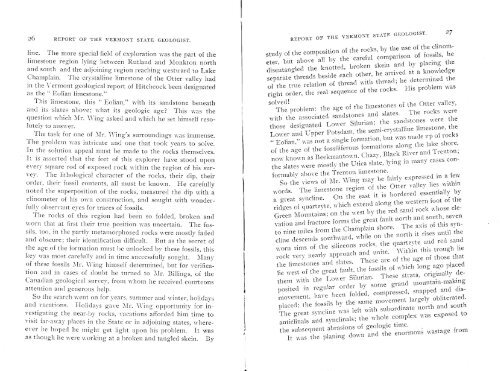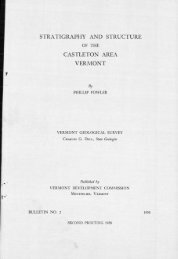Mineral Industries and Geology of Certain Areas - Vermont Agency ...
Mineral Industries and Geology of Certain Areas - Vermont Agency ...
Mineral Industries and Geology of Certain Areas - Vermont Agency ...
You also want an ePaper? Increase the reach of your titles
YUMPU automatically turns print PDFs into web optimized ePapers that Google loves.
26 REPORT OF THE VERMONT STATE GEOLOGIST.<br />
REPORT OF THE VERMONT STATE GEOLOGIST<br />
27<br />
line. The more special field <strong>of</strong> exploration was the part <strong>of</strong> the<br />
limestone region lying between Rutl<strong>and</strong> <strong>and</strong> Monkton north<br />
<strong>and</strong> south <strong>and</strong> the adjoining region reaching westward to Lake<br />
Champlain. The crystalline limestone <strong>of</strong> the Otter valley had<br />
in the <strong>Vermont</strong> geological report <strong>of</strong> Hitchcock been designated<br />
as the Eolian limestone."<br />
This limestone, this " Eolian," with its s<strong>and</strong>stone beneath<br />
<strong>and</strong> its slates above; what its geologic age? This was the<br />
question which Mr. \Ving asked <strong>and</strong> vhich he set himself resoluteiv<br />
to answer.<br />
The task for one <strong>of</strong> Mr. Wing's surrotindings was immense.<br />
The problem was intricate <strong>and</strong> one that took years to solve.<br />
In the solution appeal must he macic to the rocks themselves.<br />
It is asserted that the feet <strong>of</strong> this explorer have stood UPOfl<br />
every square rod <strong>of</strong> exposed rock within the region <strong>of</strong> his survev.<br />
The lithological character <strong>of</strong> the rocks, their dip, their<br />
order, their fossil contents, all must be known. He carefulIr<br />
noted the superposition <strong>of</strong> the rocks, measured the dip with a<br />
clinometer <strong>of</strong> his own construction, <strong>and</strong> sought with wonderfully<br />
observant eves for traces <strong>of</strong> fossils.<br />
The rocks <strong>of</strong> this region had been so folded, broken <strong>and</strong><br />
worn that at first their true position was uncertain. The fossils,<br />
too, in the partly metamorphosed rocks were mostly faded<br />
<strong>and</strong> obscure; their identification difficult. But as the secret <strong>of</strong><br />
the age <strong>of</strong> the formation must be unlocked by these fossils, this<br />
key was most carefully <strong>and</strong> in time successfully sought. Many<br />
<strong>of</strong> these fossils Mr. Wing himself determined, but for verification<br />
<strong>and</strong> in cases <strong>of</strong> doubt he turned to Mr. Billings, <strong>of</strong> the<br />
Canadian geological survey, from whom he received courteous<br />
attention <strong>and</strong> generous help.<br />
So the search went on for years, summer <strong>and</strong> winter, holidays<br />
<strong>and</strong> vacations. Holidays gave Mr. Wing opportunitY for investigating<br />
the near-by rocks, vacations afforded him time to<br />
visit far-away places in the State Or in adjoining states, whereever<br />
he hoped he might g -et light upon his problem. It was<br />
as thong-h he were working- at a broken <strong>and</strong> tangled skein. By<br />
study <strong>of</strong> the composition <strong>of</strong> the rocks, by the use <strong>of</strong> the clinometer,<br />
but above all by the careful comparison <strong>of</strong> fossils, he<br />
disentangled the knotted, broken skein <strong>and</strong> by placing the<br />
separate threads beside each other, he arrived at a knowledge<br />
<strong>of</strong> the true relation <strong>of</strong> thread with thread; he determined the<br />
right order, the real sequence <strong>of</strong> the rocks. His problem was<br />
solved!<br />
The problem: the age <strong>of</strong> the limestoneS <strong>of</strong> the Otter valley,<br />
with the associated s<strong>and</strong>stones <strong>and</strong> slates. The rocks were<br />
those designated Lower Silurian; the s<strong>and</strong>stones were the<br />
Lower <strong>and</strong> Upper Potsdam, the semi_cryStalhilw limestone, the<br />
Eolian." was not a single formation, but was made up <strong>of</strong> rocks<br />
<strong>of</strong> the age <strong>of</strong> the fossiliferous formations along the lake shore,<br />
now known as Beekmantowll, Chazy, Black River <strong>and</strong> Trento1<br />
the slates were mostly the Utica slate, lying in many cases confori<br />
-nably above the Trenton limestone.<br />
So the views <strong>of</strong> Mr. Wing may be fairly expressed in a few<br />
words. The limestone region <strong>of</strong> the Otter valley lies within<br />
a great svncline. On the east it is bordered essentially by<br />
ridges <strong>of</strong> quartzyte, which extend aloog the western foot <strong>of</strong> the<br />
Green Mountains; on the west by the red s<strong>and</strong> rock vhose elevation<br />
<strong>and</strong> fracture forms the great fault north afl(l south, seven<br />
to nine miles from the Champlain shore. The axis <strong>of</strong> this syndine<br />
descends southward, while on the north it rises until the<br />
worn rims <strong>of</strong> the siliceous rocks, the quartzyte <strong>and</strong> red s<strong>and</strong><br />
rock very nearly approach <strong>and</strong> unite. Within this trough lie<br />
the himestones <strong>and</strong> slates. These are <strong>of</strong> the age <strong>of</strong> those that<br />
lie west <strong>of</strong> the great fault, the fossils <strong>of</strong> which long ago placed<br />
them with the Lower Silurian. These strata, originally de-<br />
0untain_making<br />
posited in regular order by some gr<strong>and</strong><br />
rnovement. have been folded, compressed, snapped <strong>and</strong> displaced;<br />
the fossils by the same movement largely obliterated.<br />
The great syncline was left with subordinate north <strong>and</strong> south<br />
anticlinals <strong>and</strong> synclinals the whole complex was exposed to<br />
the subsequent abrasions <strong>of</strong> geologic time.<br />
It was the planing down <strong>and</strong> the enormous<br />
wastage fro m













